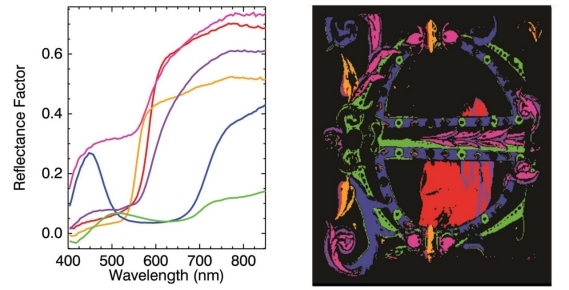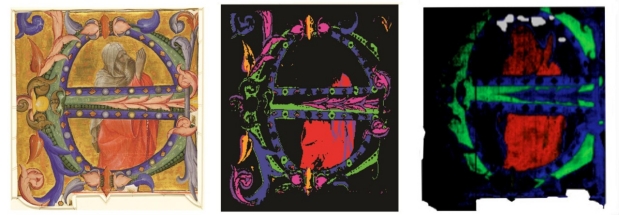Lorenzo Monaco, Praying Prophet, 1410/1413, miniature on vellum, National Gallery of Art, Rosenwald Collection
Lorenzo Monaco, Praying Prophet, 1410/1413, miniature on vellum, National Gallery of Art, Rosenwald Collection
This is an illumination from a choir book commissioned by the Camaldolese monks of Santa Maria degli Angeli in Florence at the end of the 14th century. Can the pigments and paint binders used be mapped in situ?
Hyperspectral imaging of the Prophet: The lab uses visible and near infrared (NIR) reflectance imaging spectroscopy that is the collection of contiguous calibrated spectral images to provide the reflectance spectrum for each pixel of the scene.
Image cubes, whose third dimension is spectral, are collected and calibrated. The hundreds of images are processed via an algorithms to find a minimal set of reflectance spectra that best represent the illumination.

Using the acquired set of spectra, a map is created to represent the artist’s materials. Assigning identity to materials is based on comparison with reflectance spectral databases and by noting characteristic vibrational features such as position and slope of electronic transitions.

The center map represents the pigments used by the artist and their location within the illumination. An organic yellow dye was mixed with azurite to obtain the green portion of the initial. Blue areas were painted using two grades of ultramarine blue. The orange leaves were painted with red lead and the pink leaves with an insect-derived red dye. The red robe of the prophet was painted using vermilion and a red dye-based glaze. The paint binder map unexpectedly shows the figure of the prophet painted using a fat-containing binder, most likely egg yolk (represented in red) in contrast to the decorative letter where a protein-based binder and/or gum arabic was used (seen in green and red).
Conclusions:
These new analytical methods allow for a more rapid and portable analysis that can be performed on site where collections are stored. The hope is such methods will reveal more about artists’ methods and workshop practices.
To examine how manuscript pages are made and treated by paper conservators click here to see a related project. Visit the Projects page to see research completed by conservators and scientists in a variety of departments.
Conservation Division
National Gallery of Art
2000B South Club Drive
Landover, MD 20785
[email protected]